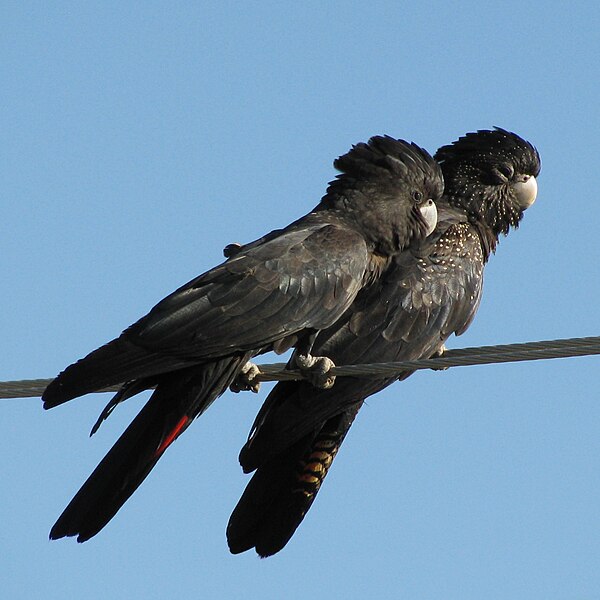Most cockatoos sport white plumage, but some of the most magnificent, typified by those in the genus Calyptorhynchus, are actually jet black in color. Although not commonly seen in captivity in the USA, they are considered highly desirable pets in their native Australia, with the red-tailed cockatoo being especially popular.
In addition to their unique plumage, these birds also distinguish themselves by unique feeding habits. In fact, several species within the genus have evolved beaks specifically adapted to a particular food source (please see below).
The Red-Tailed Black Cockatoo, Calyptorhynchus banksii
 I’ll start off with my favorite. The original species name, “magnificus”, was truly fitting. Males are jet black with brilliant red tail patches; females have a brownish cast to the plumage and their tails bear orange-yellow bands. The contrast of these colors against one another is quite striking – you will not soon forget your first look at this bird.
I’ll start off with my favorite. The original species name, “magnificus”, was truly fitting. Males are jet black with brilliant red tail patches; females have a brownish cast to the plumage and their tails bear orange-yellow bands. The contrast of these colors against one another is quite striking – you will not soon forget your first look at this bird.
Four subspecies are found across Eastern, Northern and Western Australia, where they are noted for two unique characteristics – the loud clicking sounds made by their broad, powerful bills when feeding and their odd habit of flying about on moonlit nights.
Red-tailed cockatoos vary greatly in their behavior from place to place. Some populations are nomadic, appearing suddenly at locales from which they have long been absent, perhaps in concert with a favored food. Others are regular migrants and can be counted on to appear and move off on a seasonal schedule.
The Black Cockatoo, Calyptorhynchus funereus
 Two subspecies of this impressive bird (recently considered species by some authorities), aptly named the yellow-tailed black cockatoo and the white-tailed black cockatoo, inhabit widely separated regions of coastal southeastern and southwestern Australia. Their habitats vary as well, with the yellow tailed subspecies being restricted to wet woodlands and the white tailed black cockatoo favoring dry scrubland.
Two subspecies of this impressive bird (recently considered species by some authorities), aptly named the yellow-tailed black cockatoo and the white-tailed black cockatoo, inhabit widely separated regions of coastal southeastern and southwestern Australia. Their habitats vary as well, with the yellow tailed subspecies being restricted to wet woodlands and the white tailed black cockatoo favoring dry scrubland.
The upper mandible of the black cockatoo is elongated and sharp, an adaptation that assists it in extracting wood-boring beetle grubs from within tree limbs and logs. In addition to this unusual fare, the black cockatoo also takes food items favored by other cockatoos, including seeds, fruit, nuts and flower blossoms.
Black cockatoos are said to form particularly strong pair bonds. When feeding, sentries are always posted to warn of approaching danger.
The Glossy Cockatoo, Calyptorhynchus lathami
This impressive brownish-black bird is limited in range to a narrow band of coastal Eastern Australia from central Queensland to Eastern Victoria. An isolated population inhabits Kangaroo Island, off the coast of South Australia.
Within this range, the glossy cockatoo frequents a variety of habitat types, including temperate rainforest, dry woodlands and dense mountain thickets. The deciding factor in its distribution seems to be the presence of its favorite food, the seeds of the Casuarina tree, especially the species C. littoralis. The glossy cockatoo’s odd, bulbous beak is uniquely adapted for opening the cones within which are found the seeds that make up the bulk of its diet.
The Palm Cockatoo, Probosciger aterrimus
This magnificent bird, the largest of all cockatoos and nearly the largest parrot, is all black with bright red cheek patches. It is not closely related to the black cockatoos described above, and is even more unique in appearance and habits. I had the good fortune to be involved in the hand-rearing of two confiscated palm cockatoo chicks. Please see my article, Hand rearing Palm Cockatoos, for more information.
Further Reading
You can learn more about the natural history and conservation status of the black cockatoos at http://www.birdlife.org/datazone/species/index.html?action=SpcHTMFindResults.asp&hdnAction=SEARCH&hdnPageMode=0&cboFamily=-2&txtGenus=Calyptorhynchus&txtSpecies=&txtCommonName=&cboRegion=-2&cboCountry=-2.
Images referenced from Wikipedia and posted by Peter Campbell and Snowmanradio
 That Bird Blog – Bird Care and History for Pet Birds
That Bird Blog – Bird Care and History for Pet Birds
